Venison is the meat from deer. Deer embraces a range of animals from moose and elk to smaller roe deer. Because venison has less fat that beef it tends to be drier when cooked. This characteristic also means frozen venison can be stored longer than beef without spoiling.
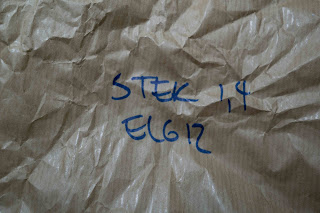 |
| The label on the brick in the freezer |
Last Christmas we were visited by The Professor from Norway who came bearing a gift of a frozen brick – a piece elg meat. Now 12 months and one week later this was to form the base for our New Year’s dinner. When I contacted her about how to prepare it she couldn’t remember much about it – ‘probably cook it in the oven’ was the most advice I could get.
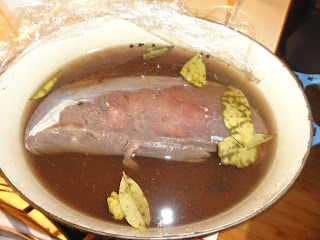 |
| Elg joint after 18 hours of brinification |
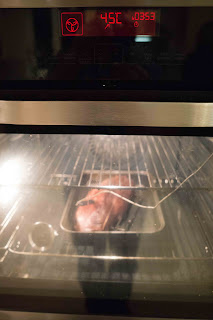 |
| Oven cooking with oven thermometer and meat thermometer |
Oven cooking. The target temperature for the meat was 60 deg celsius. To ensure a long cook with minimum drying out I set the oven temperature itself to 60 degrees. I used a separate oven thermometer to check the oven setting, and a meat thermometer to probe the meat. After 6 hours the meat temperature appeared to be around 55 degrees at the centre. I stopped the cooking and allowed the meat to rest for 20 minutes. Actually this seemed strange as my normal resting procedure is to move the meat from a hot oven to a warming drawer, but on this occasion the warming drawer was a similar temperature to the main oven.
Searing. One of the most important flavours of meat comes from the Maillard reaction that happens when it is seared at a high temperature. It is common do this first prior to the main cooking process, however to reduce the drying effect I did this last after the resting. I heated a large frying pan on high gas for 5 minutes, then oiled the meat joint and turned it in the pan so it was browned on all sides.
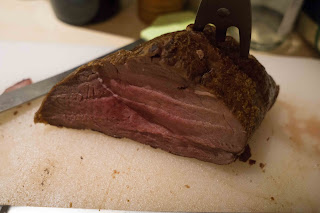 |
| Perfectly cooked – after 6 hours in the oven! |
The result:- perfectly cooked meat with a nice colour gradient from dark brown on the outside to red-pink at the centre and a moist and tender texture. Eating quality was good, but the brining contributed slightly too much saltiness without the expected flavours from the aromatics.
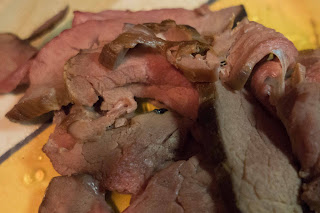 |
| Tastey eating! |
To serve with? A garnish of red cabbage cooked with apple, a celeriac and potato mash, and purple sprouting broccoli tops. mmmm.
And here’s The Professor, this Christmas more focussed on duck than elg!

Look like You have found a god soloution. Sorry for the lack of information. A Duck for next year?